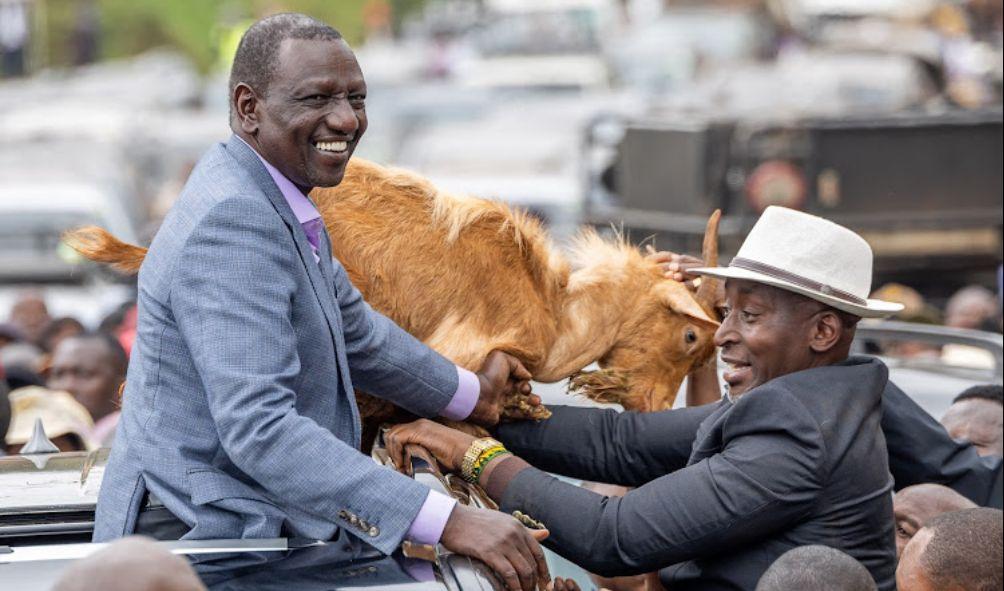Why Ruto is on Aggressive Countrywide Tours
President William Ruto’s recent nationwide tours appear to be driven by the need to justify his broad-based government and address rising youth protests.
Political analysts suggest that these intensified regional visits are aimed at easing internal government tensions, particularly following a reported rift with Deputy President Rigathi Gachagua.
Ruto’s actions also seem motivated by concerns that some of his strongholds are being overtaken by political adversaries and that his administration might be disconnected from the public.
In response, Ruto has launched a proactive tour of key areas as part of a deliberate effort to promote his inclusive government and garner support in the wake of recent protests.
The President has included former opposition figures such as Wycliffe Oparanya, Hassan Joho, John Mbadi, Opiyo Wandayi, and Beatrice Askul in his expanded government.
Despite narrowly defeating Raila Odinga in the 2022 election, Ruto’s cooperation with him now recalls the unity seen in the Pentagon alliance of 2007.
Ruto’s advisors have meticulously planned his nationwide tour to boost support for the government and address concerns after Generation Zoomers’ protests pushed it to a critical point.
ALSO READ:
- “Two Groups, One Agenda”: Gachagua Accuses Raila of Secret Political Deals
- Exclusive: Ida Odinga’s 75th Birthday Party in Karen (Photos)
- FKF President Discloses Exact Amount Paid to Harambee Stars Players
- Gachagua’s Ally Senator John Methu Admits Ruto Might Win 2027 Elections
- Maraga Explains Why He Hasn’t Campaigned in Kisii Despite 2027 Bid
Over the past two weeks, Ruto has visited seven counties in the Coast and Mount Kenya regions to consolidate his influence and seek support for his new Cabinet.
Amid ongoing protests from young Kenyans demanding a cabinet overhaul, Ruto dissolved most of his Cabinet on July 11 and announced significant policy changes.
On June 26, Ruto rejected the Finance Bill 2024, a proposed tax amendment, in response to pressure from protesters who had previously stormed Parliament.
The President also introduced measures to address concerns, including cutting various budgets and expenditures to reduce public sector costs.
Following the inclusion of key opposition figures in his Cabinet, Ruto began nationwide tours to reinforce support and promote his broad-based government.
In the last two weeks, Ruto has toured the Coast and Mount Kenya regions, with plans to visit Nyanza next week, including Kisii and Nyamira counties.
During these tours, Ruto emphasized unity and promoted his broad-based government as a solution to tribalism and ethnic divisions.
The President believes his new broad-based administration will unlock Kenya’s full potential, as stated during the swearing-in of new Cabinet Secretaries on Thursday.
Ruto contends that the inclusive government will overcome the political rivalries that have previously hindered Kenya’s progress.
ALSO READ: “Uhuru tried and failed”: Jimi Wanjigi dares William Ruto after police raid on home
Political analysts view Ruto’s tours as a strategic effort to garner support for his broad-based government and reassure his supporters of his leadership.
Former Cabinet Minister Franklin Bett views presidential tours as essential for leaders to gauge the impact of their policies and decisions firsthand.
Bett notes that Ruto’s approach mirrors past strategies focused on direct grassroots engagement and hands-on leadership.
The former MP speculates that Ruto might expand his tours to opposition strongholds as part of his 2027 re-election strategy.
Immediately after appointing former Mombasa Governor Hassan Joho as the new Mining and Blue Economy CS, Ruto embarked on a three-day tour of the Coast region.
Ruto received a warm reception in Mombasa on July 26, marking a positive shift in sentiment following recent Cabinet changes.
The President was similarly welcomed in Kilifi, Kwale, and Taita Taveta, where residents turned out to support him during the commissioning of development projects.
ALSO READ: Fearless Journalist Clashes with Police at Jimmy Wanjigi’s Home: “Niguze uone,nitazima Camera nikutandike”
Ruto explained that forming a broad-based government and appointing Joho were steps toward ensuring inclusivity and sought local support for Joho’s ministerial role.
The President’s tour of the Coast region followed a visit to Tharaka Nithi, where he reaffirmed his support for Interior CS Kithure Kindiki, recently retained in the Cabinet.
Following his visit to the Coast, Ruto continued his tour in Mount Kenya, a region previously unsettled by his tax proposals and other policies.
This tour comes amid claims by Gachagua that the Finance Bill 2024 was rejected by Kenyans due to Ruto’s lack of responsiveness to grassroots concerns.
Before Ruto’s reversal of the Finance Bill, Gachagua’s visits to Mount Kenya had helped him gain support despite widespread criticism of the Bill.
Analysts suggest that Ruto’s tour aims to counter anti-Kenya Kwanza sentiments and rally support in regions previously opposed to Raila Odinga.
The tour also serves to address any unrest caused by recent appointments of ODM figures to Ruto’s administration and maintain unity in the region.
During the visit, Ruto and Gachagua, despite their rumored rift, put on a united front to mitigate growing tensions and showcase solidarity.
Their tour included Embu, Murang’a, and Kirinyaga counties, with a pause for the swearing-in of the new Cabinet.
This visit coincides with speculation about a plot to impeach Gachagua and reports of a crackdown on his allies by DCI officers.
Gachagua, who joined Ruto on the tour, received enthusiastic support from Embu residents and pledged to monitor project progress and combat alcoholism.
In Runyenjes, Embu county, Ruto highlighted the inclusive nature of the new government, emphasizing unity and collective action to address national issues.
Why Ruto is on Aggressive Countrywide Tours
